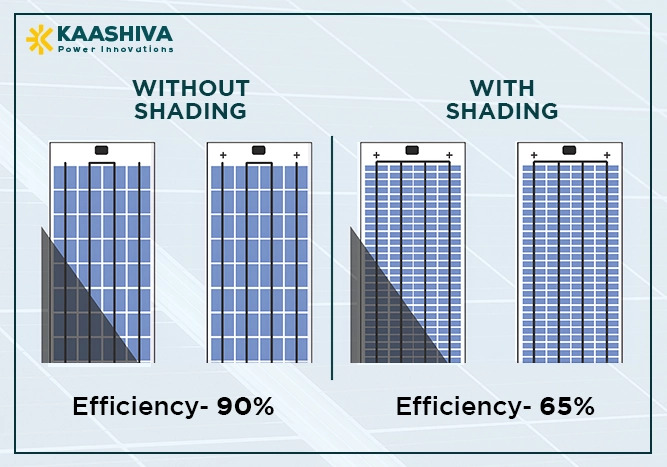
The 6 Best Ways to Improve Solar Panel Efficiency
Maximizing Solar Panel Efficiency: 6 Key Strategies

Introduction
Solar energy is an excellent way to reduce electricity bills and contribute to environmental sustainability. However, merely installing solar panels isn’t enough to maximize their benefits. To ensure that your solar panels are performing at their peak efficiency, certain practices and considerations must be taken into account. In this blog, we’ll explore six key strategies to enhance the efficiency of your solar panels, ensuring you get the most out of your investment.
1. Choose the Right Technology and Build Quality

The type and quality of solar panels you choose play a significant role in their efficiency. Modern solar technologies like Mono PERC (Passivated Emitter and Rear Cell) and bifacial solar panels have set new benchmarks in efficiency and performance.
- Mono PERC Halfcut Solar Panels: These panels offer higher efficiency due to their ability to capture more sunlight. They are also more space-efficient, making them ideal for installations where space is limited.
- Bifacial Solar Panels: These panels can capture sunlight from both the front and back, increasing their overall power generation. In optimal conditions, bifacial panels can generate up to 20% more energy than traditional monofacial panels.
By investing in these advanced technologies, you can significantly boost the energy output of your solar installation.
2. Optimize the Direction of Your Solar Panels

The direction in which your solar panels are installed is crucial for maximizing sunlight exposure. In most parts of the world, solar panels should be installed facing south to capture the maximum amount of sunlight throughout the day. This orientation ensures that your panels receive the most direct sunlight, thereby enhancing their efficiency.
If a south-facing installation isn’t possible, west or east-facing panels can also be effective, although they may generate slightly less energy. Avoid north-facing installations unless absolutely necessary, as they receive the least amount of direct sunlight.
3. Install at the Correct Angle

The angle at which your solar panels are installed can also impact their efficiency. The optimal angle depends on your geographic location and the latitude of your installation site. The general rule of thumb is that the angle of the panels should match the latitude of your location.
For example, if you’re located at a latitude of 30 degrees, your panels should be tilted at a 30-degree angle. This angle allows the panels to capture the maximum amount of sunlight throughout the year. Adjusting the angle seasonally can further optimize performance, but for most residential installations, a fixed tilt angle works well.
4. Minimize Wire Length and Maintain Proper Connections

Electrical losses can occur when the DC current generated by your solar panels travels over long distances to reach the inverter. To minimize these losses, it’s important to keep the distance between the panels and the inverter as short as possible, ideally within 10 meters.
Additionally, ensure that all electrical connections are secure and that wires are of adequate thickness to handle the current. Thicker wires reduce resistance and improve the overall efficiency of your solar power system.
5. Regular Maintenance and Cleaning

Dust, dirt, and debris can accumulate on the surface of your solar panels over time, reducing their ability to capture sunlight. Regular cleaning is essential to maintain peak efficiency. Use a soft brush and a mild soap solution to gently clean the panels, and rinse them with clean water to remove any residue.
Check for any signs of damage, such as cracks or chips, during the cleaning process. Regular maintenance not only improves efficiency but also extends the lifespan of your solar panels.
6. Avoid Shaded Areas

Shading is one of the biggest enemies of solar panel efficiency. Even partial shading can significantly reduce the energy output of your panels. During the site survey, ensure that the installation area is free from shadows cast by nearby trees, buildings, or other structures.
If shading is unavoidable, consider using microinverters or power optimizers, which allow each panel to operate independently. This technology minimizes the impact of shading on the overall system performance.
Conclusion
Maximizing the efficiency of your solar panels involves a combination of choosing the right technology, optimizing installation parameters, and regular maintenance. By following these six strategies, you can ensure that your solar panels perform at their best, providing you with clean, renewable energy for years to come.
If you’re considering installing a solar system for your home or business, Kaashiva Power offers a range of high-quality solar products designed to meet your energy needs. Contact us today to learn more about how we can help you harness the power of the sun.
3 Comments

John Doe 01 Jan 2045
Diam amet duo labore stet elitr invidunt ea clita ipsum voluptua, tempor labore accusam ipsum et no at. Kasd diam tempor rebum magna dolores sed eirmod

John Doe 01 Jan 2045
Diam amet duo labore stet elitr invidunt ea clita ipsum voluptua, tempor labore accusam ipsum et no at. Kasd diam tempor rebum magna dolores sed eirmod

John Doe 01 Jan 2045
Diam amet duo labore stet elitr invidunt ea clita ipsum voluptua, tempor labore accusam ipsum et no at. Kasd diam tempor rebum magna dolores sed eirmod



